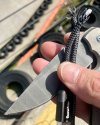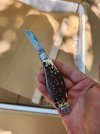I have only looked at it from a glance here and a fevered imagining there but :
For me it is mostly visual not so much practical .
HOWEVER
One tack , which is not even "real" damascus (but it applies to the OLD question : Why damascus ? ) . . . is . . . Clading . Make the core out of tool steel , which tends to be a bit prone to snapping off if overly hardened
.
(I like overly hardened (think file hard knife blade )).
thennnnnn the dudes who enjoy flailing at each other with swords got the idea to put tough / less hardenable steel on each side of the "snap right off " tool steel to . . . kind of shore it up a bit .
because . . . well . . . it was a bit embarrassing when this kept happening :
1:30 into vid . . .





